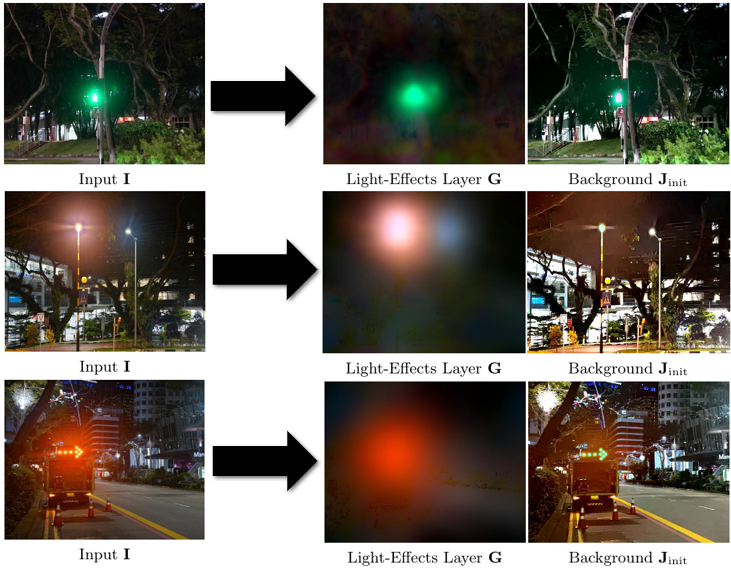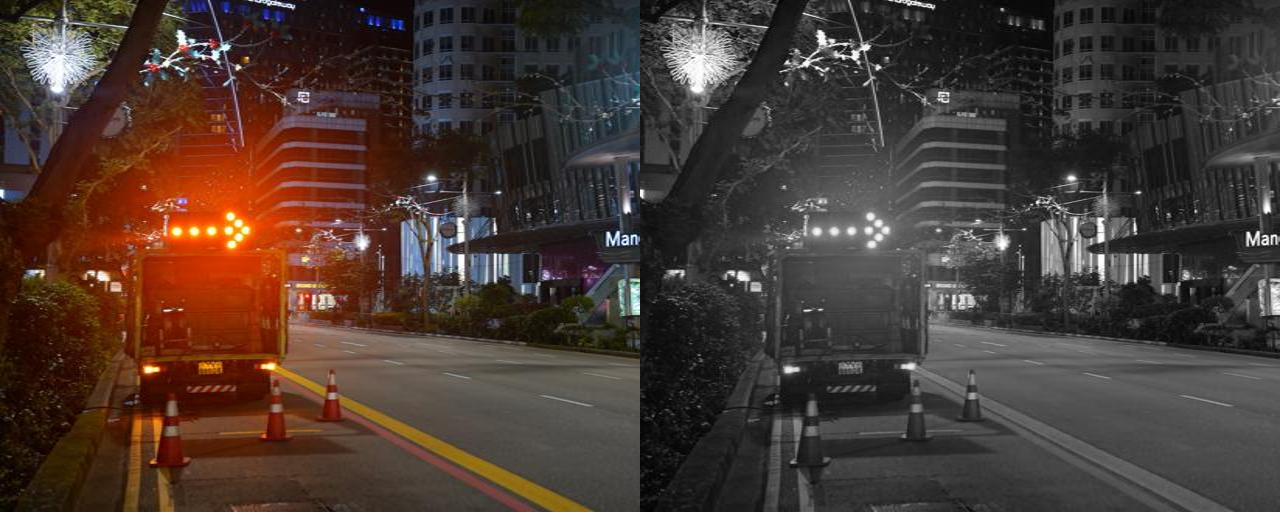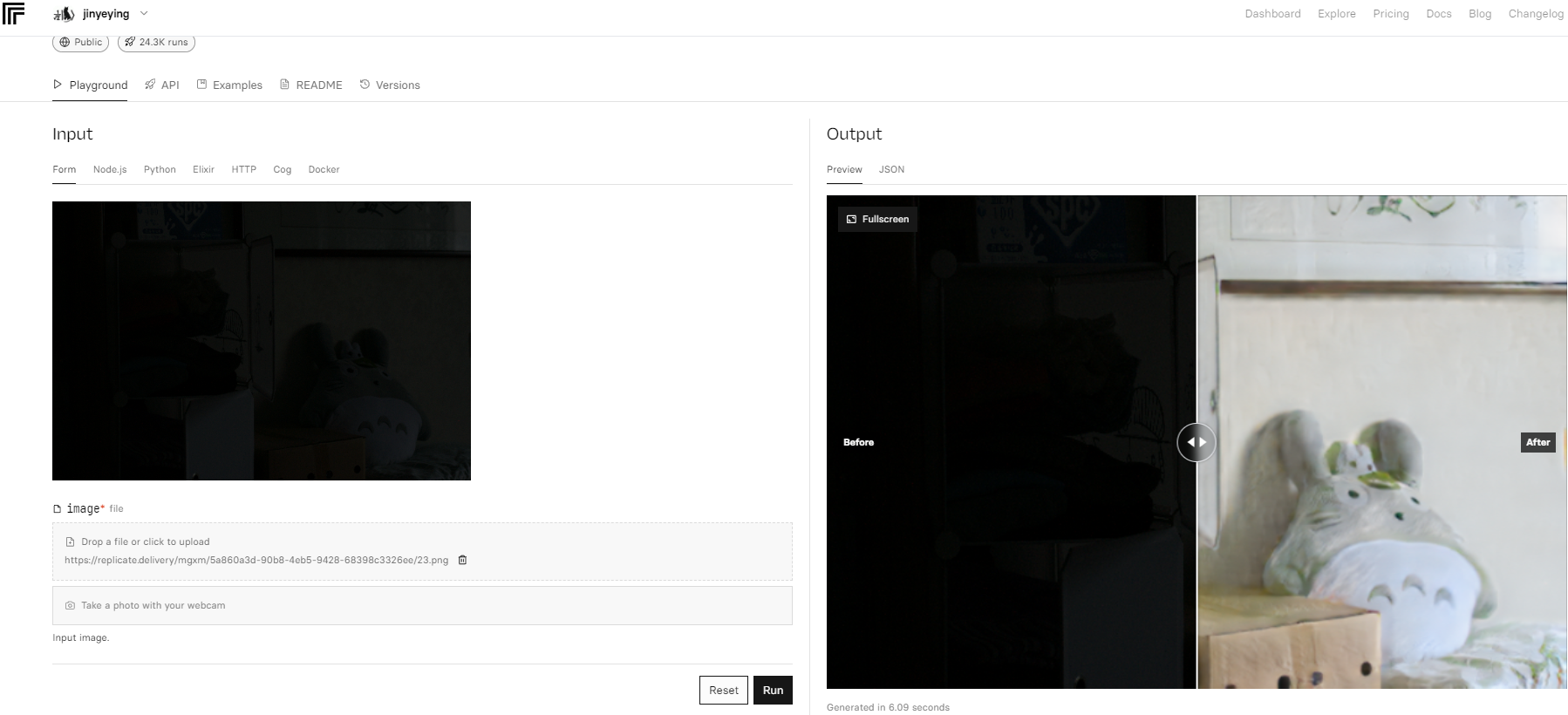This is an implementation of the following paper.
Unsupervised Night Image Enhancement: When Layer Decomposition Meets Light-Effects Suppression
European Conference on Computer Vision (ECCV2022)
Yeying Jin, Wenhan Yang and Robby T. Tan
[Paper]
[Supplementary]

Night images suffer not only from low light, but also from uneven distributions of light. Most existing night visibility enhancement methods focus mainly on enhancing low-light regions. This inevitably leads to over enhancement and saturation in bright regions, such as those regions affected by light effects (glare, floodlight, etc). To address this problem, we need to suppress the light effects in bright regions while, at the same time, boosting the intensity of dark regions. With this idea in mind, we introduce an unsupervised method that integrates a layer decomposition network and a light-effects suppression network. Given a single night image as input, our decomposition network learns to decompose shading, reflectance and light-effects layers, guided by unsupervised layer-specific prior losses. Our light-effects suppression network further suppresses the light effects and, at the same time, enhances the illumination in dark regions. This light-effects suppression network exploits the estimated light-effects layer as the guidance to focus on the light-effects regions. To recover the background details and reduce hallucination/artefacts, we propose structure and high-frequency consistency losses. Our quantitative and qualitative evaluations on real images show that our method outperforms state-of-the-art methods in suppressing night light effects and boosting the intensity of dark regions.
- Light-effects data
Light-effects data is collected from Flickr and by ourselves, with multiple light colors in various scenes.
CVPR2021Nighttime Visibility Enhancement by Increasing the Dynamic Range and Suppression of Light Effects [Paper]
Aashish Sharma and Robby T. Tan
- LED data
We captured images with dimmer light as the reference images.
- GTA5 nighttime fog
Synthetic GTA5 nighttime fog data.
ECCV2020Nighttime Defogging Using High-Low Frequency Decomposition and Grayscale-Color Networks [Paper]
Wending Yan, Robby T. Tan and Dengxin Dai
- Syn-light-effects
Synthetic-light-effects data is the implementation of the paper:
ICCV2017A New Convolution Kernel for Atmospheric Point Spread Function Applied to Computer Vision [Paper]
Run the Matlab code to generate Syn-light-effects:
glow_rendering_code/repro_ICCV2007_Fig5.m
[Update] We released the light-effects suppression code and checkpoint on May 21, 2023.
- Download the pre-trained de-light-effects model, put in
./results/delighteffects/model/ - Put the test images in
./light-effects/
python main_delighteffects.py
[Update] We released demo_all.html and demo_all.ipynb code on May 21, 2023.
Inputs are in ./light-effects/, Outputs are in ./light-effects-output/
demo_all.ipynb
[Update] We released the demo.py code on Dec 28, 2022.
python demo.py
[Update] We released the decomposition code on Dec 28, 2022.
Run the code to decomposition layers, output light-effects layers, and initial background layers.
demo_decomposition.m
Background Results | Light-Effects Results | Shading Results
- Run the MATLAB code to adaptively fuse the three color channels, and output
I_gray.
checkGrayMerge.m
-
Download the fine-tuned VGG model (fine-tuned on ExDark), put in
./VGG_code/ckpts/vgg16_featureextractFalse_ExDark/nets/model_best.tar -
Obtain structure features.
python test_VGGfeatures.py
-
LOL dataset
LOL: Chen Wei, Wenjing Wang, Wenhan Yang, and Jiaying Liu. "Deep Retinex Decomposition for Low-Light Enhancement", BMVC, 2018. [Baiduyun (extracted code: sdd0)] [Google Drive] -
LOL-Real dataset
LOL-real (the extension work): Wenhan Yang, Haofeng Huang, Wenjing Wang, Shiqi Wang, and Jiaying Liu. "Sparse Gradient Regularized Deep Retinex Network for Robust Low-Light Image Enhancement", TIP, 2021. [Baiduyun (extracted code: l9xm)] [Google Drive]
We use LOL-real as it is larger and more diverse.
- Download the pre-trained LOL model, put in
./results/LOL/model/ - Put the test images in
./LOL/
🔥🔥 Online test: https://replicate.com/cjwbw/night-enhancement
python main.py
Get the following Table 4 in the main paper on the LOL-Real dataset (100 test images).
| Learning | Method | PSNR | SSIM |
|---|---|---|---|
| Unsupervised Learning | Ours | 25.51 | 0.8015 |
| N/A | Input | 9.72 | 0.1752 |
[Update]: Re-train (train from scratch) in LOL_V2_real (698 train images), and test on LOL_V2_real (100 test images).
PSNR: 20.85 (vs EnlightenGAN's 18.23), SSIM: 0.7243 (vs EnlightenGAN's 0.61)
pre-trained LOL_V2 model
Get the following Table 3 in the main paper on the LOL-test dataset (15 test images).
| Learning | Method | PSNR | SSIM |
|---|---|---|---|
| Unsupervised Learning | Ours | 21.521 | 0.7647 |
| N/A | Input | 7.773 | 0.1259 |
The code and models in this repository are licensed under the MIT License for academic and other non-commercial uses.
For commercial use of the code and models, separate commercial licensing is available. Please contact:
- Yeying Jin (jinyeying@u.nus.edu)
- Robby T. Tan (tanrobby@gmail.com)
- Jonathan Tan (jonathan_tano@nus.edu.sg)
If this work is useful for your research, please cite our paper.
@inproceedings{jin2022unsupervised,
title={Unsupervised night image enhancement: When layer decomposition meets light-effects suppression},
author={Jin, Yeying and Yang, Wenhan and Tan, Robby T},
booktitle={European Conference on Computer Vision},
pages={404--421},
year={2022},
organization={Springer}
}
@inproceedings{jin2023enhancing,
title={Enhancing visibility in nighttime haze images using guided apsf and gradient adaptive convolution},
author={Jin, Yeying and Lin, Beibei and Yan, Wending and Yuan, Yuan and Ye, Wei and Tan, Robby T},
booktitle={Proceedings of the 31st ACM International Conference on Multimedia},
pages={2446--2457},
year={2023}
}If light-effects data is useful for your research, please cite the paper.
@inproceedings{sharma2021nighttime,
title={Nighttime Visibility Enhancement by Increasing the Dynamic Range and Suppression of Light Effects},
author={Sharma, Aashish and Tan, Robby T},
booktitle={Proceedings of the IEEE/CVF Conference on Computer Vision and Pattern Recognition},
pages={11977--11986},
year={2021}
}




